Saturday, March 06, 2004
Billon antoninianus, Antioch, Gallienus, Göbl 1571d
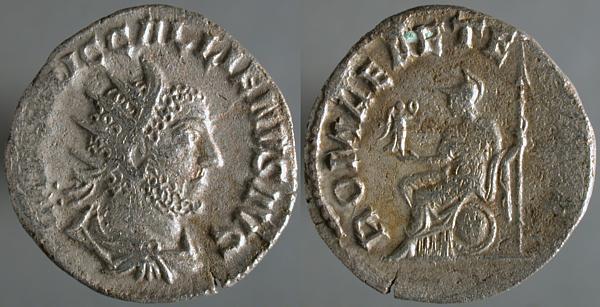
IMP C P LIC GALLIENVS AVG, Radiate draped cuirassed bust right | ROMAE AETERNAE, Roma seated left on shield, holding spear right and Victory left.
We've looked at this basic reverse design before, and noted that it serves as a model for British and American coin designs of the 18th and 19th centuries.
This obverse features Gallienus with curly hair & beard, which is unusual him, but standard for this particular coin. The link up in the post title shows this and another example, both with curly hair & beard. This shows up rarely on a few apparently-contemporary coins, presumably using the same obverse dies as the ROMAE AETERNAE coins.
I don't think anyone knows why. In the Loeb Classical Library (and look at the Loeb emblem!) translation of the Emperor Julian's The Caesars, Gallienus is seen "with the dress and languishing gait of a woman" and "decked with gold and dainty as a maid," and there's a tradition that he dusted his hair with gold. Whether there's any relation between this coin and whatever events are behind those stories is impossible to know.
Friday, March 05, 2004
Æ23, Iconium in Lycaonia, Gallienus, BMC 12
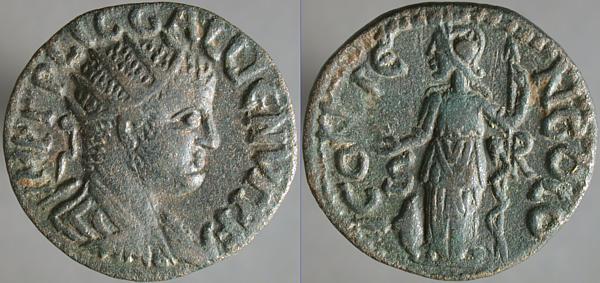
IMP Γ P LIC GALLIENVΓ P F A, Radiate draped cuirassed bust right | ICONIE_N COLO, Athena standing facing (on prow?), head left, holding snake-entwined spear right, shield? at feet left. S_R across fields..
Iconium was quite close to Pisidian Antioch, and is today Konya, Turkey.
The execution of the portrait, as a generic portrait, isn't bad, very Asia Minor, but it doesn't look like Gallienus. The gammas in the obverse legend are just strange.
Thursday, March 04, 2004
Billon antoninianus, Viminacium, Valerian, Göbl 836b
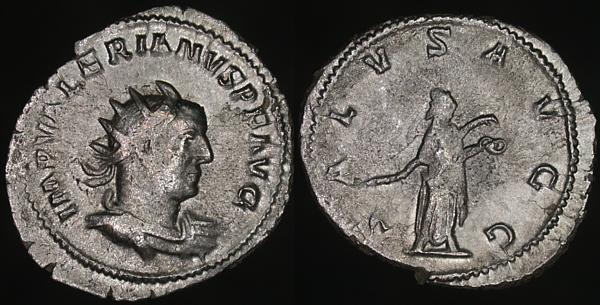
IMP VALERIANVS P F AVG, Radiate draped cuirassed bust right | SALVS AVGG, Salus standing facing, head right, holding snake in arms, feeding from patera right.
Salus, the Roman goddess of health, was like the Greek Hygeia, and was frequently featured on Roman coins. While public hygeine in Rome was probably better than anywhere elese in the classical world, still epidemics were common and subject to no better control than sacrifice and prayer.
Wednesday, March 03, 2004
AR denarius, Rome, Marc Antony, 42 BCE, Sear 1467, RSC 12 or 12a
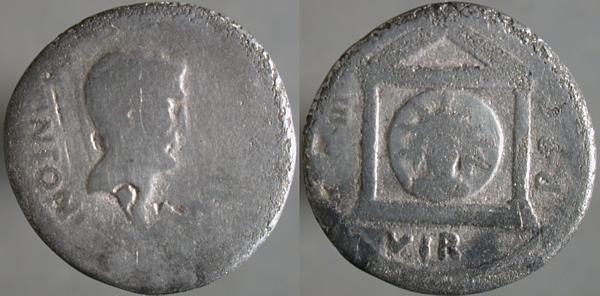
M ANTONI IMP, Bare head right | III VIR R P C, Radiate bust of Sol facing, in distyle temple.
Rather badly worn, but still: a portrait of Antony, made while he was still alive, and on his instruction!
Julius Caesar was two years dead, Tiberius was a newborn, and Augustus was merely Octavianus, 20 years old. For the moment Antony and Octavian were allied against Cassius and Brutus. In this year the armies of the conspirators were defeated, and these two would contend for control for another 11 years, with Antony finally committing suicide after being defeated by Octavian's army and by his general Marcus Agrippa.
Tuesday, March 02, 2004
Æ23, Antioch in Pisidia, Valerian, Lindgren I, 1250var
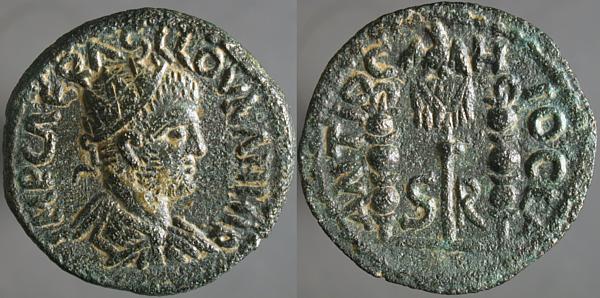
IMP CAERAS LL OVNAHHIR, Radiate cuirassed bust right | ANTIOC_H_IO CLA, Vexillum with eagle, head left, on top between two standards. S R across fields.
Similar in design to Sunday's coin of his son, it's one of the best-preserved examples I've seen from Pisidian Antioch. The spelling of the legends, as on Sunday, is idiosyncratic, though the bust, reverse, and letter forms aren't bad. My best guess is someone at least somewhat literate in Greek, rather less so in Latin.
Monday, March 01, 2004
Billon antoninianus, Antioch, Gallienus, Göbl 1630inote
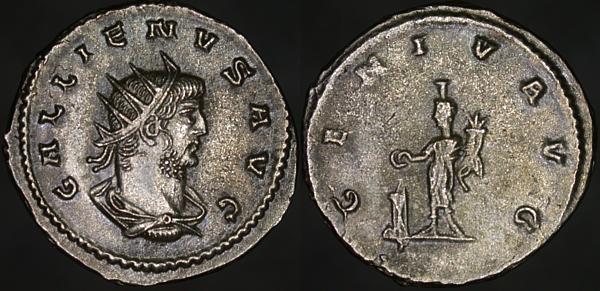
GALLIENVS AVG, Radiate draped cuirassed bust right | GENIV AVG, Genius standing facing, head left, holding cornucopia right, sacrificing from patera onto flaming tripod left.
On Saturday, I mentioned a coin that I had thought lost in the mail, which showed up some weeks late. This is it. I'm still quite pleased that it's safe.
Sunday, February 29, 2004
Æ23, Antioch in Pisidia, Gallienus, Lindgren I, 1256var
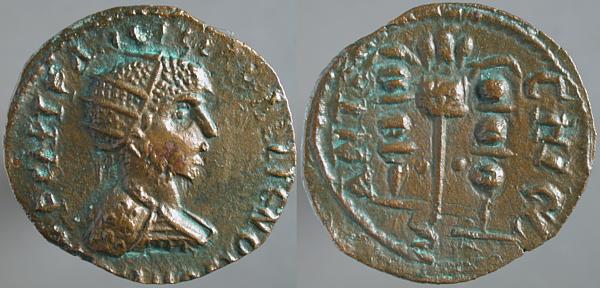
IMP CAET P AN LICIA GALLIENO CIO II IPO(?), Radiate cuirassed bust right | ANTIO_CH ICL, Vexillum with eagle on top between two standards. S R in exergue.
Like many cities with colony status, coins of Antioch featured Latin legends. In Imperial times, colony status was often extended to cities that were home to retired legionary soldiers and to those that served as home base to active legions. Pisidian Antioch was both. This reverse, featuring legionary standards, which had religious significance to the soldiers, was common on the provincial coins of Antioch in the third century.
The apparent literacy of the mint engravers here was in decline by the time of Philip I, and it did not improve over time. (The portraits were no great shakes either.)
This is, by the way, a different Antioch than Antioch ad Orentem in Syria, an imperial mint city of this era.

